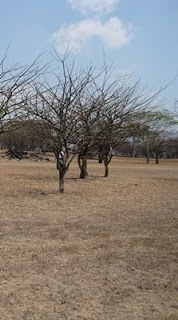Natural Medicine for Tour Guides?
We decided to eat lunch before hiking up the big hill to the lookout over the lake. We sat in the shade on benches made from long bamboo "logs." We munched on sandwiches, bags of chips and sweet fruit drinks. A week ago Ruben had been feeling very weak, but his diet of mora (wild spinach) soup had clearly renewed his energy. Sonia knows a great deal about plants, and as we talked about the different types of trees and shrubs on the steep hills which stretch up from the lakeshore, Ruben joined the conversation. Ruben, like Sonia, knows every plant by multiple names and is wise in the gathering and making of natural medicines.
Lilian is shy, but recognizing the gifts of Ruben as a healer, she mentioned a problem she has been having with her ears. Ruben asked her some questions, determining she had both pain and decreased hearing, and then he gave her three treatment options:
1) Crush fresh wild basil in a little cotton cloth so that the juice is on the cloth. Put the tiny package of basil cloth into your ear (not in the canal, but just near the opening). Leave it in their for a while and the pain will go away.
2) Do the same as above but with wild oregano.
3) Dig in the dirt to find this tiny little bug with pincers and stick in your ear. In a little while you grab it and pull it out, and it pulls the ear clog with it. Then the bug returns to nature, and you can hear.
Ruben was not joking, and clearly Sonia had heard of this bug treatment before. Lilian did not seem convinced, and a few of the Salvadoran girls and US delegation members who overheard this were also unconvinced and even squeamish. We tidied up the lunch and walked up the trail through the woods, climbing to the lookout. I noticed Lilian gathered some basil along the way. Yeah, better choice than the bug option.
The next day, the delegation traveled out to visit Joya de Cerén. This is an internationally recognized historical site featuring excavated remains of a farming village from about 500 AD. The village was buried by volcanic ash, and preserved until 1976 beneath initial deposits and subsequent layers of ash and soil. As we wandered around the site reading and taking photos, Sonia pointed out a patch of dry soil covered by pattern of small holes and rings. "These holes are made by the bugs that Ruben was talking about yesterday," she said.
What???
The ear bugs??
"They are really tiny but very mighty. They have to have strong pincers to make these big holes. They only live in dry soil, which is why they are here beneath this canopy [which protects the excavations]."
Seriously, the ear bugs.
Rest assured that if you are ever a member a delegation with me in El Salvador and find yourself suffering with hearing loss due to gunk in your ear, I now know where the ear-pincer-bugs live, and note that they are conveniently located at a great tourist site.
Lilian is shy, but recognizing the gifts of Ruben as a healer, she mentioned a problem she has been having with her ears. Ruben asked her some questions, determining she had both pain and decreased hearing, and then he gave her three treatment options:
1) Crush fresh wild basil in a little cotton cloth so that the juice is on the cloth. Put the tiny package of basil cloth into your ear (not in the canal, but just near the opening). Leave it in their for a while and the pain will go away.
2) Do the same as above but with wild oregano.
3) Dig in the dirt to find this tiny little bug with pincers and stick in your ear. In a little while you grab it and pull it out, and it pulls the ear clog with it. Then the bug returns to nature, and you can hear.
Ruben was not joking, and clearly Sonia had heard of this bug treatment before. Lilian did not seem convinced, and a few of the Salvadoran girls and US delegation members who overheard this were also unconvinced and even squeamish. We tidied up the lunch and walked up the trail through the woods, climbing to the lookout. I noticed Lilian gathered some basil along the way. Yeah, better choice than the bug option.
The next day, the delegation traveled out to visit Joya de Cerén. This is an internationally recognized historical site featuring excavated remains of a farming village from about 500 AD. The village was buried by volcanic ash, and preserved until 1976 beneath initial deposits and subsequent layers of ash and soil. As we wandered around the site reading and taking photos, Sonia pointed out a patch of dry soil covered by pattern of small holes and rings. "These holes are made by the bugs that Ruben was talking about yesterday," she said.
What???
The ear bugs??
"They are really tiny but very mighty. They have to have strong pincers to make these big holes. They only live in dry soil, which is why they are here beneath this canopy [which protects the excavations]."
Seriously, the ear bugs.
Rest assured that if you are ever a member a delegation with me in El Salvador and find yourself suffering with hearing loss due to gunk in your ear, I now know where the ear-pincer-bugs live, and note that they are conveniently located at a great tourist site.


Comments
Post a Comment